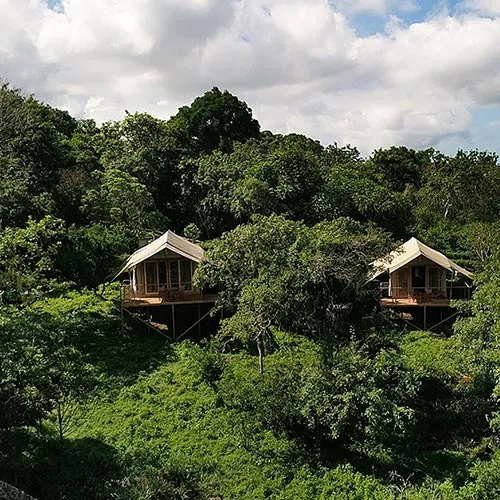Sea Lions: At a glance
- Scientific name: Zalophus wollebaeki
- Taxonomy: Mammalia > Carnivora > Otariidae > Zalophus
- Conservation Status: Endangered
- Endemic to the Galapagos Islands: Almost. Some breeding colonies exist on Isla de la Plata, a small island just off the coast of mainland Ecuador. However, this site is not regularly used.
- The Galapagos Sea Lion is the smallest of the world’s six species of sea lion, yet it’s the largest land animal in the Galapagos
- Adult females weigh approximately, 75kg, and adult males (bulls), 250kg
- Sea lions are excellent divers. They can hold their breath for over 10 minutes, and dive to depths of almost 600m.
- You can find them all over the archipelago, often lying on benches in harbors or parked on sandy beaches like sleeping dogs.
- Sea lions are very curious, and can be playful companions when snorkeling.
View this post on Instagram
From California to Galapagos
The Galapagos sea lion purportedly hails from the north —the California sea lion (Zalophus californianus) being its closest relative —but it is scientifically considered a separate species, the smallest sea lion species in the world. It has a smaller muzzle than California sea lions, as well as smaller sagittal crests (the bumps on the males’ heads that denote how much of a male they are!).
View this post on Instagram
Delayed Implantation
The sea lion’s mating season varies from island to island, although generally it falls within the second half of the year. Mating takes place in the water, and within 1 to 4 weeks of a cow giving birth. Given this short turn-around, there is a period of ‘delayed implantation’. The embryo isn’t planted in the womb for two months. This remarkable evolutionary adaptation enables the cow to give birth at at time when the environmental conditions are favorable. That is, when the nutrient-rich Humboldt current sweeps up into the Galapagos, attracting more fish, and more food for the sea lions.
View this post on Instagram
Boy pups more demanding
A pup will nurse on its mother’s milk for up to 2 years, and will start foraging for its own food from around 6 months to a year.
Interestingly, one study found that juvenile males were more dependent on their mother’s milk than the juvenile females. Daughters were the most active divers and hunters, meaning that the mother must invest more in male pups than females. The reasoning behind this, however, remains unclear. Some suggest that males can potentially sire more pups per year than females (who can only produce one pup per year), thereby making the mother’s early investment worthwhile. Although this behaviour remains something of a mystery, it does raise many more questions about these curious Galapagos mammals and their family dynamics.
View this post on Instagram
Natural herders
Another extraordinary discovery about the Galapagos sea lion occurred off a remote part of Isabela Island. A local fisherman had told BBC cameraman, Richard Wollocombe, about a sea lion that could herd big oceanic tuna fish out of the sea and onto the shore. Realizing this was a story that couldn’t be ignored, Richard decided to check it out for himself. After obtaining all the necessary permits he set up camp alongside ‘overly friendly iguanas and pelicans’, and he didn’t have to wait long before the event happened:
“On the first morning there was a commotion in the bay and sure enough, a sea lion had chased a tuna from the open ocean right into the shallows: we could hardly believe our eyes! It was a huge fish! “
Over the next few weeks Richard and his assistant studied this remarkable behaviour, and were the first to ever capture it on film. The footage was used in the BBC’s Blue Planet 2 series.
“Normally there was one sea lion that would instigate the hunt and we could hear them all calling to each other – almost like players on a football field. However, it wasn’t until Dan got the drone in the air and we watched the footage back that their game plan became obvious – there was always a driver which was often a younger sea lion we called ‘tag boy’, with a small yellow tag on his flipper. You’d then see him peel off and block the deepest channel, keeping the fish in the shallows, the other sea lions would then flank the main group of fish and drive them ever shallower.”
View this post on Instagram
Low Metabolic Rate
Other studies have shown that the the Galapagos sea lion has the lowest metabolic rate of any sea lion measured to date. This may well explain its ability to survive in waters that are warmer and less productive than oceans at higher latitudes. However, if the oceans continue to warm, this evolutionary adaptation might not be enough to sustain them. The particularly harsh El Niño of 1997-8 caused a 90% pup mortality, 67% alpha male mortality and a 50% population decrease.
View this post on Instagram
Sea Lions vs Seals
It’s easy to confuse sea lions with the fur seal, but there are a few differences that your naturalist guide will point out to you. These include:
- Snouts: Sea lions have longer snouts than fur seals
- Size: Sea lions are considerably bigger than fur seals
- Skin: Fur seals have a thicker coat and more fur than sea lions. As such, they tend to avoid the sun during the day, preferring shaded areas under bushes or rocks.
- Hunting times: Fur seals hunt at night, while sea lions hunt during the day.
- Eyes: Fur seals have big, protruding eyes to help them see at night when they are hunting.
- Ears: Fur seals have ears that stick out
Plan your Galapagos Vacation
See our Safari Holidays for our suggested Galapagos itineraries and recommended activities.
